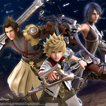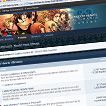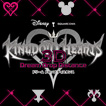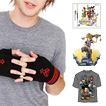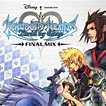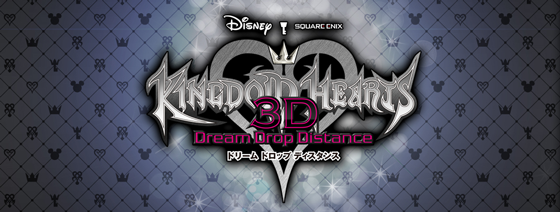KH3D Ultimania Staff Interviews
The Japanese only guide, Kingdom Hearts 3D Ultimania, has a total of 22 staff interviews that have them discuss their role in creating the game and any secrets during the process. Goldpanner has began translating them and will continue to update as they are completed. Keep in mind that these do contain spoilers so please read them at your own risk!!
Tamotsu Goto
Lead Programmer / From: Osaka Development Team / Previous titles: KH Re:CoM, KH BbS, Brave Fencer Musashi, Musashi: Samurai Legend
Q. What did you find difficult in programming for the 3DS?
A. The 3DS has 3D-vision was well as top and bottom screens, and on top of that, there were many terrains that had to be broadened, it was fairly difficult to realise the performance necessary to bring the Flowmotion in this title to life. Nakamichi (Mr. Masashi Nakamichi) did his very best for me in that area, and I believe that consistently the action we made feels good and the graphics are colourful and flashy.
Q. Are there any elements that came from ideas put forward from the programmer’s side?
A. There was a period where we were sweating blood because the design of the ‘Flick Rush’ game just wouldn’t gel, and from an enthusiastic exchange between the planners and the programmers in charge of the task, I think it ended up coming together very nicely.
Q. What was the biggest hardship you faced?
A. Producing a new title in about one year was extremely difficult. We were able to appropriate the gameplay from KH BbS to a certain degree, but there were also many new parts we had to make, and there were also hardships involving making it possible for work on the planning side and programming side to progress simultaneously. I was actually doubting we could complete it in one year, so the early stages of development they whittled down many specifications for me, but as development progressed new specifications were added on, and in the end the volume exceeded what we had original planned. I am so grateful to my brilliant tough staff who managed it.
Q. If you have an unforgettable memory from during development, please share it with us.
A. When we were submitting the master ROM, there was a severe bout of influenza going around, so I told all the programmers to take care. However, four days before we were to submit the master ROM, I alone caught it, and not being able to be present for the most important moment was an incredibly crushing memory. I’ll never forget it as long as I live.
Secret of this title that only he knows:
3DS memory capacity is comparatively large, and because in the early stages of development I ran my mouth saying things like ‘we still have this much we can use,’ in the last half of development we had a lot of trouble making ends meet with memory.
Masashi Nakamichi
Sub-Lead Programmer / From: Osaka Development Team / Previous titles: KH Re:CoM, KH BbS, Musashi: Samurai Legend
Q. What did you find difficult in programming for the 3DS?
A. Creating the system that would allow all the scenes to be viewed in 3D without falling apart was very difficult. If there are errors in the graphics it will be exposed in the 3D picture, so I had to fine-tune it over and over.
Q. If there was something you fine-tuned in order to make use of the functions of the 3DS, please share it with us.
A. It has top and bottom screens, so I tried to come up with ideas that made use of both screens, like Reality Shift.
Q. What was the most difficult part of production?
A.I took care to create a sense of unity with the KH Series, making sure I was able to reproduce the representation and look of KHI and KHII on the 3DS without a sense of incongruity.
Q. What was the biggest hardship you faced?
A.The development period was comparatively short, and the designers on the planning side began planning data early, so in the beginning, both the data planning and the gameplay planning on the programmer’s side were going at the same time. Because of that, the process went backwards to how it normally goes, with data being made and then us creating systems to express it on the 3DS afterwards, that was very difficult.
Q. If you have an unforgettable memory from during development, please share it with us.
A. New hardware, new title, short development period; there was always a feeling of tension on this project, and I think the memory of the entire time is something I’ll never forget. Thank you to all the many people who worked with me.
Q. What is something about this title you particularly want people to see?
A.Using Flowmotion you can get to many places on the huge maps, so I hope people enjoy searching around.
Secret of this title that only he knows:
In the cutscene from Xehanort’s perspective that runs right after the opening of the game, we had to make his head smaller so it wouldn’t show on the camera. Looking at it from another perspective you see he has a normal body with a tiny little dot of a head on top, it had me in stitches. It’s such a shame I can’t show you.
Misao Ohara
Art Director: Interface / From: Osaka Development Team / Previous titles: KH BbS, KH Re:Coded
Q. What did you worry about in terms of the interface?
A.Adjusting the space between icons and text etc. in measurements of one dot, trying to display a good deal of information without it feeling cramped or the lettering becoming hard to read.
Q. How did you come up with the idea for the Spirit growth screen?
A. To match the Spirit’s colourful bodies, we went with cute colours and rounded designs for everything. We also went with the touch screen as the main controls, because we wanted people to feel they could touch the Spirit directly and enjoy getting close to them.
Q. What was the biggest hardship you faced?
A. Finding how to fit so much information on the screen. Especially the bottom screen, where you have to make the buttons large enough that they are easy to touch. As a screen with a large volume of information, it was very difficult to balance functionality as a touch screen.
Q. What is something about this title you particularly want people to see?
A. The Interface staff were also involved in designing the Dream Eaters, so we would love people to see and enjoy the Spirit growth section. It’s even fun to just watch them moving around on their own inside the screen, so please try playing with your Spirits more and more on the growth screen.
Q. If you have an unforgettable memory from during development, please share it with us.
A. The time we decided on the Dream Eaters names had quite an impact on me (laughs). Among them were some Dream Eaters whose names got much longer than expected, and we had to hurry and adjust the section for displaying their names. Like particularly, ‘kumadadaisaakusu’ (Ursa Circus)…
Secret of this title that only he knows:
I’m sure many people have noticed, but Meowjesty’s colour and design includes a black body, lines along the brow, red pants, yellow feet… like Mickey.
Asako Suga
Dialogue Editor / From: Tokyo Development Team / Previous titles: KH Series, FFVII Advent Children, Crisis Core -FFVII-, Dissidia FF
Q. What was the biggest hardship you faced?
A. There were many worlds appearing for the first time in the series, and so as I worked I watched DVDs of the original works over and over listening to the lines and adjusting things to make the atmosphere as close as I could. It was a huge job.
Q. What’s your favourite line?
A. The conversation between Sora and Riku on Destiny Islands that you hear in the opening of the game. They’re the same lines from KHI, so during recording I listened to the voices from KHI for reference as I worked. Those lines had been recorded in that exact studio around ten years before, and I was recalling those days and reflecting on the ten years that have passed.
Q. Were there any voiced parts that were cut for some reason?
A. With the KH series we record lines while looking at a storyboard, and then the cutscenes are made after that, you see, and with this title they planned the cutscenes with the goal to ‘use all the recorded lines!’. Thanks to that, character’s movements were adjusted to suit ad-libbed voices, and I didn’t have to shed a single tear over a line getting cut and shelved!
Q. If you have an unforgettable memory from during development, please share it with us.
A. The same members have worked in the KH series sound team for many titles now, so even if the production time is short, we band together and back each other up… though in my case I was just receiving back up (laughs). My best memory is how we could all have so much fun working together!
Secret of this title that only she knows:
It took five months in total to record the voices, but the last recording was done a month and a half before the development deadline! I was pretty scared because it was the first time I’d cut it so close, and I am relieved now it’s managed to reach you all.
Masaru Oka
Scenario & Cutscene Director / From: Tokyo Development Team / Previous titles: KH Series, FFVII, FFVIII, FFX, FFXIII, Crisis Core -FFVII-, Rudra no Hihō
Q. What was the theme you most wanted to depict in the story of this title?
A. The bond between Sora and Riku’s hearts. Sora and Riku have to be separated at the beginning of the story, but the bond between two hearts that trust each other closes the distance between the two of them and causes them to impact on each other.
Q. If there was something you came up with to make use of the functions of the 3DS, please share it with us.
A. The 3D for cutscenes is delicately tuned. Some thought that the subtitles were difficult to look at, so this is the first game in the series that provides an on/off option for subtitles.
Q. What’s your favourite cutscene?
A. The scene talking with Xehanort from Sora’s perspective, at the beginning of Side: Sora’s The World that Never Was. Particularly the part in Traverse Town, because Sora is looking around and running, and coupled with the 3D I think you really do get inside Sora’s feelings.
Q. Where there any rejected cutscenes?
A. Not rejected as such, but in the beginning we planned the battle with Rinzler in The Grid to be Side: Riku. Before the start of that battle they announce the ‘thirteen combatants’, and though we didn’t consciously choose the number ‘13’, changing it to Side: Sora gave it an unexpected deep meaning.
Q. What is something about this title you particularly want people to see?
A. I really want people to try out the 3D vision and see the Disney and KH characters depicted in 3D. But of course only as much as won’t tire their eyes (laughs).
Q. What do you want to challenge yourself with in the next title?
A. When you think of Disney of course what comes to mind is the songs. I want to try writing a scenario that incorporates musicals and songs.
Secret of this title that only he knows:
In The World That Never Was, there’s a scene in which, if you don’t fulfil the prerequisites, Riku is forced to drop (see p.216). For this scene Mr. Mamoru Miyano who plays Riku ad-libbed four patterns for us. It’s not in the theatre so please, fans, try not to miss it (laughs).
Takeshi Nozue
Cinematic Movie Director / From: Square Visual Works / Previous titles: KH Series, FFIX, FFX, FFXIII, FFVII Advent Children, Dissidia FF, Dissidia Duodecim FF, Tomb Raider
Q. If there was anything you included with special intent, please share it with us.
A. Being the ten year anniversary, I wanted to put more energy into the opening movie for this title than anything so far. Of all my projects KH is the one with the most pressure and I intended to put my heart into being true to everyone’s hopes.
Q. If there was something you came up with to make use of the functions of the 3DS, please share it with us.
A. With the Mickey in the opening movie, I was introduced through co-operation with Disney to animation supervisor Mr. (Nobuo) Tomisawa, and we were able to bring to life that depiction in traditional animation. I believe that the opening movie we created, viewable in 3D as well as using both top and bottom screens, made full use of the functions of the 3DS.
Q. What was the most difficult part of production?
A. The scene where Destiny Islands becomes a pop-up picture book. In the role of unskilled leader of the staff of Square Visual Works (studio in charge of movie production) I asked for design and gimmick plans. The drive and determination was incredible, I was very happy to be able to watch them grow.
Q. If you have an unforgettable memory from during development, please share it with us.
A. Even with the pressure, I had a lot of fun developing. I came to the office alone on Golden Week and worked happily listening to the orchestral version of ‘Hikari’ turned way up loud in the dark (laughs).
Q. What do you want to challenge yourself with in the next title?
A. The art of graphics has very much evolved, and so I’d like to try producing realtime graphics in movie quality. Also, this is just a dream or a wish, but I’d like to try doing a full-length KH movie.
Secret of this title that only he knows:
During production I received a phone call from (Mr. Tetsuya) Nomura, and he told me he wanted me to definitely make sure to alter a particular scene. When I asked the reason, I remember my astonishment at being told so quickly the shocking story
Takeshi Fujimoto
Art Director / From: Osaka Development Team / Previous titles: KH Re:CoM, KH BbS, Brave Fencer Musashi, Musashi: Samurai Legend, FFXI, Parasite Eve II
Q. For production of this title, what sort of maps did you think of making?
A. In this title Sora and Riku’s movements are dynamic, so they can move a long distance in one action. On a small map they would be able to go from end to end right away, so when we made the maps we took care to incorporate play elements into them and made them as big as possible.
Q. What is your favourite map?
A. No matter which map I think of I like them all, but if I was forced to say, I’d say Traverse Town’s post office, perhaps. The platforms have hugely varying heights and there are many rails set up so you can ‘rail slide’, which made it feel refreshing to play, and I think to look at it is all arranged very cheerfully.
Q. Which map was difficult to bring to life?
A. The World That Never Was. There are many maps that change form, with chopping buildings and going upside down, so it was a huge job to optimise the memory and graphics processing.
Q. What was the biggest hardship you faced?
A. Making the polygons used to express the proper look of the glass in The Grid etc. show translucence. There are many restrictions on translucent polygons, and as it was there were flickers meddling with the technique’s effect and it coming out looking weird. In order to make it look natural we had to make full use of subtle techniques.
Q. What is something about this title you particularly want people to see?
A. One characteristic of the KH series is the completely different touch to every single world’s setting, so I would like for people to enjoy the different flavours in that regard. We finished this game to feel like a ‘portable Disneyland’, so please play it forever.
Secret of this title that only he knows:
On the world map, the unopened worlds are made so that you can’t see what’s in them. I thought of the design when I was drinking tapioca juice. There are black bits swimming around inside, please check it out for yourself.

